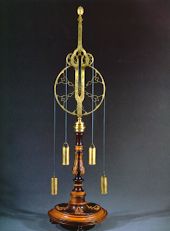
77 x 21.5
Brass and carved wood
INDEX 1788 : H.I.179
Rota affabre elaborata eo constructa artificio, ut eodem tempore, quo ejus axis ascendit vel descendit, ipsa rota in orbem vertatur.
Wheel, artistically decorated and cunningly constructed so that as its axle rises or falls, the wheel revolves at the same time.
This device is one of the finest pieces in the Gabinete de Física. As described by Nollet in Lessons in Experimental Physics, it was intended to show that the change of direction of one of the forces in a balanced system causes movement in the system.
The apparatus consists of a wheel (in fact a pulley) with its axle suspended from four cords, two at each end. The cords pass round four small fixed pulleys, set parallel to the main wheel, two at each side. After passing round a pair of these pulleys, each pair of cords is brought together into one cord, and a weight hangs from each of these two united cords. Another cord passes round the moveable wheel, with weights hanging from each end so that the apparatus is balanced.
The following theory of how the apparatus was used seems to correspond to its main original aim.
The simplest experiment consists in moving the cords hanging from the wheel symmetrically away from the vertical. Although this process also involves a change in the tension of all the cords, its main effect is to lessen the vertical projection of the tension force of the cords on the wheel. The magnitude of the resultant force is then no longer equal to zero, thus causing imbalance in the system. The wheel, together with the weights hanging from it, begins to move upwards, while the weights hanging from the fixed pulleys descend.
The other, more spectacular effect, mentioned by Nollet and by dalla Bella, is achieved by changing the angle of only one of the cords. The wheel then begins to move vertically, rotating at the same time. In this case it is not only the resultant force which changes: the axle of the wheel, forced to move vertically within a groove, shows the action of a binary of forces with a non vanishing torque, causing the rotation.
In the Museum's piece, the wheel and pulleys and the framework holding them are made of brass; the lower part is of dark and light wood, finely carved, ending in a circular base supported by three feet. Small cylindrical brass containers for holding weights hang from the cords.
Carvalho, Rómulo de, História do Gabinete de Física da Universidade de Coimbra, Universidade de Coimbra, Biblioteca Geral, Coimbra, 1978, pp. 327-328.Nollet, Jean-Antoine, Leçons de Physique Experimentale, Paris, 1764, Vol.VIII, Leçon IX, p. 84.